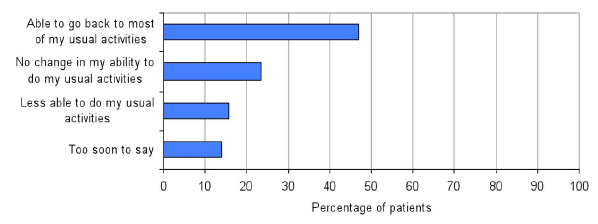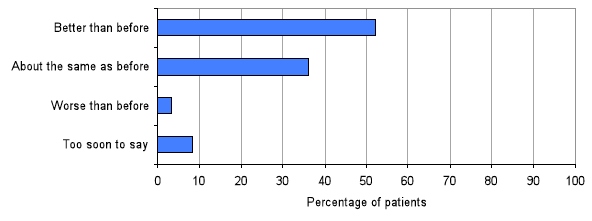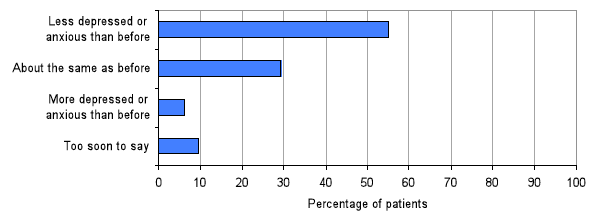Patient Experience survey of GP and local nhs services 2011/12 Volume 1: National Results
Scottish Patient Experience Survey of GP and Local NHS Services 2011/12. This is a postal survey which was sent to a random sample of patients who were registered with a GP in Scotland in October 2011. This report contains the national results, comparisons between NHS Boards and international comparisons.
This document is part of a collection
10 Outcomes from NHS treatments
Introduction
10.1 One of the key actions identified in the Quality Strategy7 was to "Improve and embed patient-reported outcomes and experience across all NHS Scotland services". Patient Reported Outcome Measures (PROMs) are recommended in the Quality Strategy for use across NHS Scotland for service improvement, as well as to track outcomes nationally as a quality outcome indicator.
10.2 While the survey was designed to better understand people's experience of NHS services locally and nationally, there were no questions asking patients how they felt about their outcomes from NHS treatment. A small number of new questions were therefore developed to test the idea of measuring this across Scotland, with the intention to use the data to calculate a Quality Outcome Indicator. This is detailed at the end of the chapter.
10.3 The new questions are based around three dimensions of health status - pain, ability to do usual activities and anxiety/ depression. They ask people about their experience of the impact of treatment on these three dimensions separately. While it is recognised that people cannot easily quantify change in health status, they are able to identify whether or not they have experienced an improvement. The "too soon to say" option allowed an answer for people who have been treated but are not yet expected to see a benefit.
10.4 These questions were added on an experimental basis as, while they tested well on individual patients it was not clear how they would work on a larger scale. At the aggregate level they should give some measure of the impact of treatment and show improvement over time. While the questions are not specific enough to be directly useful for local improvement (e.g. we do not know what treatments people have had, or where they had them), the results raise some interesting questions that merit further research with patients.
10.5 The results of these questions are not specifically related to GPs, therefore they have not been included in the individual practice reports. However, the NHS Boards and CHP reports will include these results, which will be used to further explore how well services are meeting people's needs and expectations.
10.6 More research is needed to better understand these results, and how they relate to people's expectations of their outcomes as well as the impact of treatment and co-existing conditions.
People's ability to do their usual activities
10.7 Respondents were asked if they had received NHS treatment or advice in the last year because of something that was affecting their ability to do their usual activities.
- 35 per cent of patients answered yes
10.8 The results are shown in Chart 12. Of patients who had sought treatment or advice, 47 per cent were able to go back to most of their usual activities. However 16 per cent were less able to do their usual activities.
Chart 12: The effect of treatment on patients' ability to do their usual activities

Pain or discomfort
10.9 Patients were asked if they had received NHS treatment or advice because of something that was causing them pain or discomfort.
- 58 per cent of patients answered yes
10.10 Of patients who had sought treatment or advice, 52 per cent reported that the effect of the treatment was to make them feel better than before. The results are shown in Chart 13.
Chart 13: The effect of treatment on pain or discomfort

Depression or anxiety
10.11 Patients were asked if they had received NHS treatment or advice because of something that was making them feel depressed or anxious.
- 17 per cent of patients answered yes
10.12 Of patients who had sought treatment or advice, 55 per cent reported that the effect of the treatment was to make them feel better than before. The results are shown in Chart 14.
Chart 13: The effect of treatment on pain or discomfort

Quality Outcome Indicator
10.13 The Quality Strategy emphasises the importance of measurement, and a Quality Measurement Framework has been developed8 in order to provide a structure for describing and aligning the wide range of measurement work with the Quality Ambitions and Outcomes. As part of this framework, 12 national Quality Outcome Indicators have been identified, which are intended to show national progress towards achievement of the Quality Ambitions.
10.14 One of these twelve Quality Outcome Indicators relates to Patient Reported Outcomes. While initial proposals envisaged that this indicator would be built up from local patient feedback information, it was recognised that this would require long term development and that therefore a high level indicator should be captured using this national survey.
10.15 The initial value of the Patient Reported Outcomes Quality Outcome Indicator is 75.2, based on the outcomes questions reported above. Further information on how the indicator has been calculated is available in the technical report. It should be kept in mind that this indicator represents a score and not a percentage value.
10.16 Results by NHS Board are presented in Table 10 below:
Table 10: Outcome Indicator by NHS Board
| NHS Board | Outcomes indicator | 95% confidence Interval | |
|---|---|---|---|
| Lower limit | Upper limit | ||
| NHS Ayrshire & Arran | 74.1 | 73.2 | 75.0 |
| NHS Borders | 76.3 | 74.9 | 77.6 |
| NHS Dumfries & Galloway | 74.8 | 73.5 | 76.1 |
| NHS Fife | 74.2 | 73.3 | 75.1 |
| NHS Forth Valley | 75.1 | 74.2 | 76.0 |
| NHS Grampian | 77.1 | 76.3 | 77.8 |
| NHS Greater Glasgow and Clyde | 74.1 | 73.7 | 74.5 |
| NHS Highland | 77.7 | 77.0 | 78.5 |
| NHS Lanarkshire | 73.6 | 72.9 | 74.3 |
| NHS Lothian | 76.0 | 75.5 | 76.6 |
| NHS Orkney | 78.5 | 75.9 | 81.1 |
| NHS Shetland | 78.4 | 75.8 | 81.1 |
| NHS Tayside | 75.8 | 75.0 | 76.7 |
| NHS Western Isles | 79.4 | 77.2 | 81.6 |
| Scotland | 75.2 | 75.0 | 75.4 |
Contact
Email: Gregor Boyd
There is a problem
Thanks for your feedback